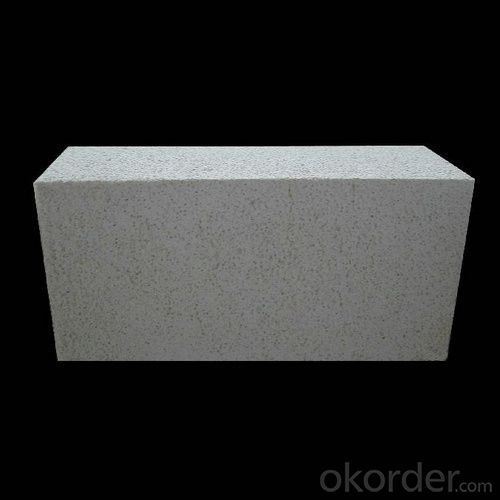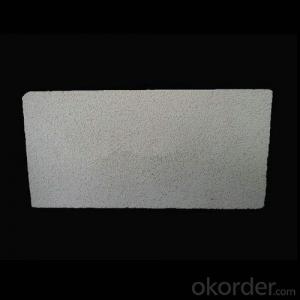ISO Certificate Insulating Firebrick for Furnace
- Loading Port:
- Shanghai
- Payment Terms:
- TT OR LC
- Min Order Qty:
- 1 m.t.
- Supply Capability:
- 1000000 m.t./month
OKorder Service Pledge
OKorder Financial Service
You Might Also Like
Introduction of insulating firebrick
Insulating brick is sintered mainly with supper-fine bauxite charlotte and propr additive by a method of EPS ignition loss. Refractory high alumina EPS insulating brick for heating furnace is a kind of insulation refractory product, taking bauxite as main raw material and including not less than 48% of AL2O3.
Characteristics of insulating firebrick
1.High porosity
2.Small volume density
3.Good insulation effect
4.High mechanical intensity
5.Small thermal conductivity
6.Long service life
Application of insulating firebrick
1. Building materials for blast furnace
2. Building materials for hot-blast stove
3. Building materials for coke oven
4. Building materials for steel making furnace
5. For construction material in steel industry
6. For ladle

Physical and chemical indexes of insulating firebrick
Brand | Clay insulating bricks | High Alumina insulating bricks | |||||
NG-0.5 | NG-0.6 | NG-0.8 | NG-1.0 | LG-0.6 | LG-0.8 | LG-1.0 | |
Bulk density g/cm3 ≤ | 0.5 | 0.6 | 0.8 | 1 | 0.6 | 0.8 | 1 |
Crushing strength Mpa ≥ | 1.5 | 2 | 2.5 | 3.4 | 1.96 | 2.94 | 4 |
The experimental temperature of linear change ≤2% | 1250 | 1300 | 1350 | 1350 | 1350 | 1400 | 1450 |
Thermal conductivity 350±25(W/m.k) ≤ | 0.18 | 0.25 | 0.35 | 0.5 | 0.25 | 0.032 | 0.45 |
Refractoriness under load | 1160 | 1250 | 1280 | 1300 | 1300 | 1350 | 1380 |
Al2O3 % ≥ | 35 | 40 | 42 | 42 | 50 | 52 | 52 |
Fe2O3 % ≥ | 2.5 | 2.5 | 2 | 2 | 1.8 | 1.6 | 1.5 |
Maximun erice temperature | 1150 | 1200 | 1280 | 1300 | 1300 | 1350 | 1380 |
FAQ
Q2: What`s the lead time for my order?
A2: It depends on customers’ requirements and our production schedule. And usually we need 30-60 days for refractory bricks,10-25 days for unshaped refractory materials and 10-20 days for ceramic fiber blankets.
Q3: Can you offer Door-to-Door delivery?
A3: Yes, but only for some countries such us U.S., UAE, Saudi Arabia, Iran, and Russia, etc.
- Q:Can insulating fire bricks be used in the construction of coke ovens?
- Yes, insulating fire bricks can be used in the construction of coke ovens. These bricks are specifically designed to withstand high temperatures and provide excellent insulation, making them suitable for coke ovens where extreme heat is generated during the coke-making process. The insulating properties of these bricks help maintain the desired temperature inside the oven while minimizing heat loss, resulting in more efficient and effective coke production.
- Q:Refractory bricks, burner bricks, insulation bricks? Is it a kind of thing?
- The burner brick is heavy brick, the use temperature is higher, the insulating brick is light brick, the use temperature is lower than the heavy brick.
- Q:Are insulating fire bricks suitable for use in oil refineries?
- Insulating fire bricks do not typically suffice in oil refineries due to their inability to withstand the corrosive and abrasive nature of oil and its byproducts, despite being designed for high temperatures. Oil refineries involve a complex process of refining crude oil into various petroleum products, which often exposes materials to harsh chemicals and high temperatures. Instead, refractory bricks or castables specifically tailored to endure the corrosive and abrasive conditions present in the refining process are commonly employed. These refractory materials possess chemical resistance, high strength, thermal shock resistance, and the ability to withstand the extreme temperatures encountered during refining. Moreover, oil refineries necessitate materials that offer excellent insulation properties while also being durable and resistant to thermal stress. While insulating fire bricks possess good insulation properties, they may not possess the necessary durability and resistance to thermal stress demanded in the demanding environment of an oil refinery. Hence, it is advisable to utilize refractory bricks or castables that are designed specifically for oil refineries. These materials can provide the requisite resistance against chemicals, high temperatures, and thermal stress, ensuring the refinery operates safely and efficiently.
- Q:Can insulating fire bricks be used as a backup insulation in refractory linings?
- Insulating fire bricks have the capability to serve as backup insulation in refractory linings. These bricks are specifically designed with low thermal conductivity, enabling them to effectively minimize heat transfer in high-temperature scenarios. Due to their insulating properties, they are an excellent choice for a secondary insulation layer in refractory linings. This not only aids in reducing heat loss but also enhances overall energy efficiency. Another advantage is their lightweight nature, which simplifies handling and installation compared to alternative refractory materials. Nonetheless, it is crucial to carefully evaluate the application's specific needs and consult with a refractory engineer to confirm the suitability of insulating fire bricks for the particular conditions and performance requirements of the refractory lining.
- Q:Can insulating fire bricks be used for kiln furniture?
- Indeed, kiln furniture can be fashioned from insulating fire bricks. These bricks are specifically engineered to endure extreme temperatures and are frequently employed in industrial kilns and furnaces. Their exceptional thermal insulation characteristics render them perfect for crafting kiln furniture like shelves, posts, and supports. The insulating attributes of these bricks aid in the uniform dispersion of heat throughout the kiln, guaranteeing consistent heating of the items being fired. Furthermore, insulating fire bricks possess a lightweight composition and are effortlessly manageable, thereby making them a convenient selection for kiln furniture.
- Q:Do insulating fire bricks have a high thermal shock resistance?
- Insulating fire bricks are commonly known for their remarkable thermal shock resistance. They are specifically engineered to endure sudden temperature variations without any fractures or damage. Crafted from lightweight refractory materials with low thermal conductivity, these bricks effectively reduce heat transfer and prevent thermal strain. Furthermore, the firing process they undergo further enhances their ability to withstand thermal shocks. In summary, these bricks are perfect for situations where extreme temperature fluctuations are encountered, making them a dependable option for insulation in high-temperature surroundings.
- Q:How do insulating fire bricks affect the overall insulation properties of a structure?
- Insulating fire bricks play a vital role in enhancing the insulation properties of a structure. These bricks are specifically designed to have low thermal conductivity, enabling them to effectively resist heat transfer. Consequently, they act as a barrier, preventing heat from escaping during cold weather and blocking external heat intrusion during hot weather. The utilization of insulating fire bricks significantly improves the overall thermal insulation of a structure. These bricks possess high porosity and low density, allowing them to trap air within their structure. This trapped air acts as an exceptional insulator, creating a thermal barrier that minimizes heat transfer through conduction, convection, and radiation. Consequently, the heat loss or gain through the walls, floors, and roofs of a building is notably reduced. Furthermore, insulating fire bricks exhibit excellent refractory properties, enabling them to withstand high temperatures without deforming or deteriorating. This characteristic is crucial in applications where the structure is exposed to extreme heat, such as industrial furnaces or kilns. By maintaining their structural integrity under high temperatures, these bricks ensure that the insulation properties of the structure remain intact even in challenging environments. Overall, the use of insulating fire bricks has a positive impact on the insulation properties of a structure. They effectively reduce heat transfer, conserve energy, and maintain a comfortable indoor environment. Additionally, their durability and resistance to high temperatures make them a dependable choice for insulation in various industrial and residential applications.
- Q:Does the building with the exterior wall thermal insulation brick require adding an angle steel bracket in the middle of the brick?
- The first thing the man has to do is to do the quality test in front of the wall. As for the second, there is not much to do.
- Q:Are insulating fire bricks resistant to impact or mechanical stress?
- Indeed, insulating fire bricks exhibit resistance against impact and mechanical stress. These bricks are crafted using lightweight refractory materials, purposefully formulated to endure extreme temperatures and thermal shock. Their composition is specifically engineered to possess exceptional resilience against mechanical stress and impact, rendering them appropriate for a multitude of applications in which external forces or pressure may be exerted upon them. Remarkably, these bricks retain their structural integrity and durability, safeguarding their shape and thermal insulation attributes even when subjected to mechanical stress or impact. Consequently, they are highly recommended for deployment in furnaces, kilns, and other environments characterized by elevated temperatures.
- Q:Do insulating fire bricks have a high electrical resistivity?
- Insulating fire bricks are generally characterized by their high electrical resistivity. This characteristic arises from their specific design, which aims to minimize thermal conductivity and maximize thermal resistance. Consequently, the insulating materials employed in these bricks, including alumina, silica, and other refractory materials, exhibit inherently high electrical resistivity. Moreover, the manufacturing procedures frequently incorporate the incorporation of insulating additives, thereby augmenting the electrical resistivity of the fire bricks. Consequently, insulating fire bricks prove to be highly effective in mitigating heat transfer and sustaining elevated temperatures across diverse industrial applications, such as kilns, furnaces, and thermal insulation systems.
1. Manufacturer Overview |
|
|---|---|
| Location | |
| Year Established | |
| Annual Output Value | |
| Main Markets | |
| Company Certifications | |
2. Manufacturer Certificates |
|
|---|---|
| a) Certification Name | |
| Range | |
| Reference | |
| Validity Period | |
3. Manufacturer Capability |
|
|---|---|
| a)Trade Capacity | |
| Nearest Port | |
| Export Percentage | |
| No.of Employees in Trade Department | |
| Language Spoken: | |
| b)Factory Information | |
| Factory Size: | |
| No. of Production Lines | |
| Contract Manufacturing | |
| Product Price Range | |
Send your message to us
ISO Certificate Insulating Firebrick for Furnace
- Loading Port:
- Shanghai
- Payment Terms:
- TT OR LC
- Min Order Qty:
- 1 m.t.
- Supply Capability:
- 1000000 m.t./month
OKorder Service Pledge
OKorder Financial Service
Similar products
New products
Hot products
Related keywords


























